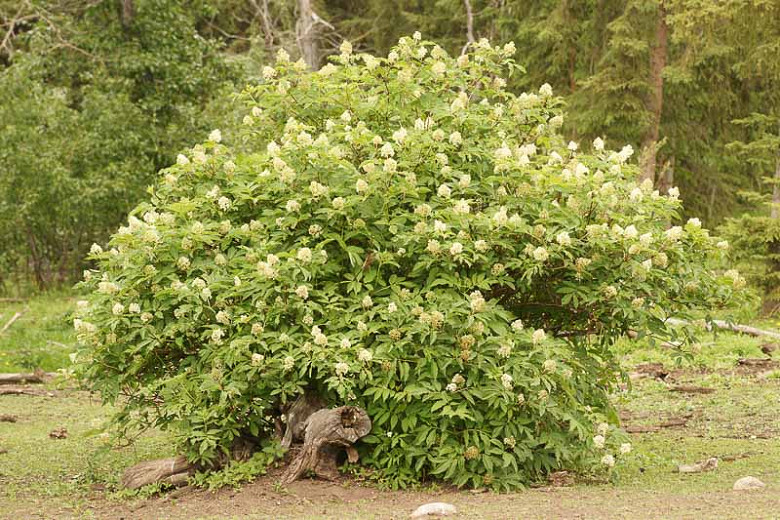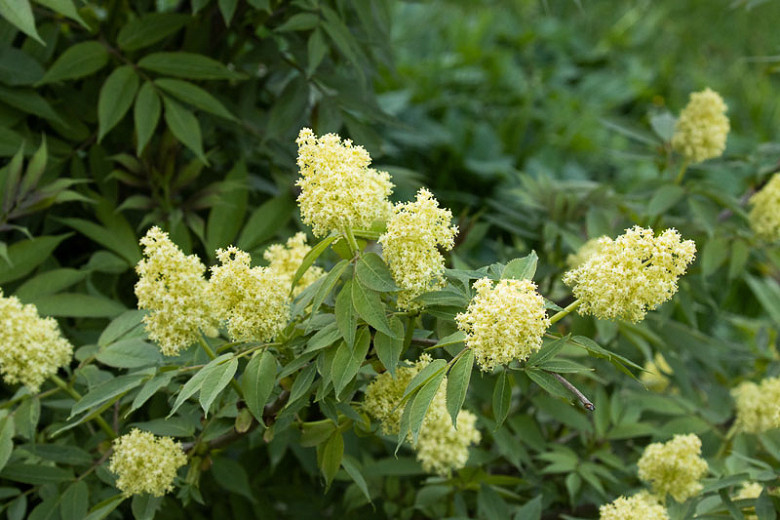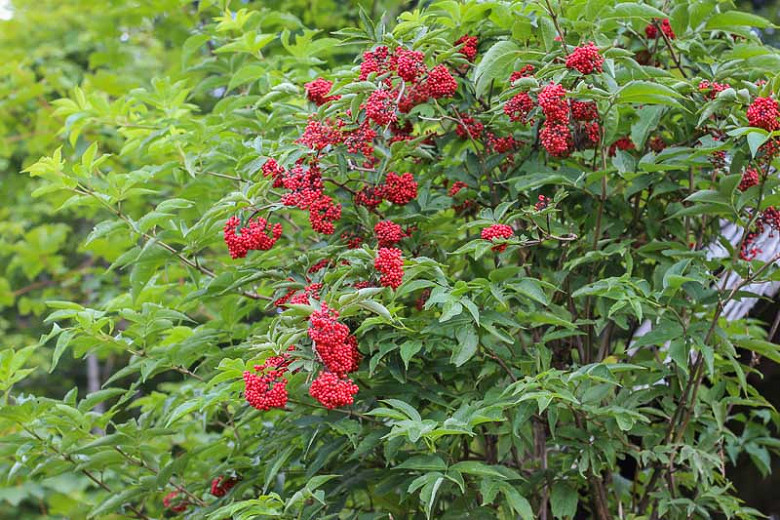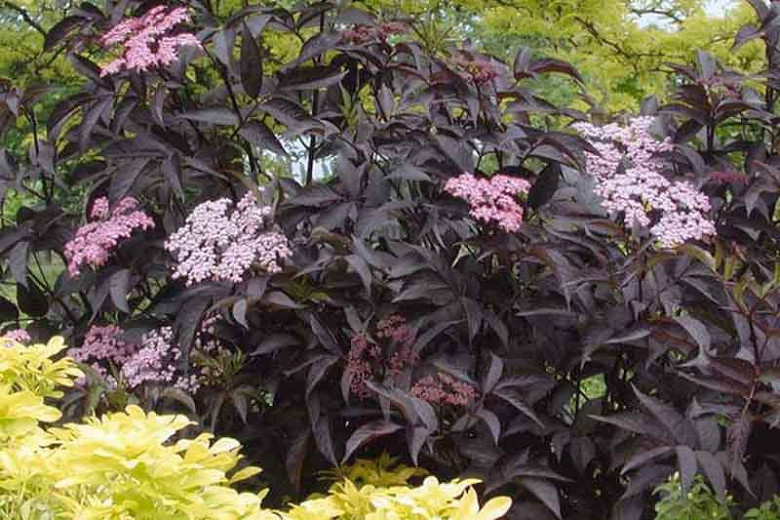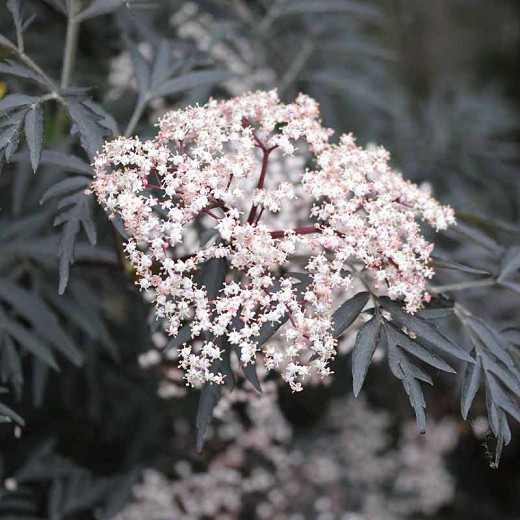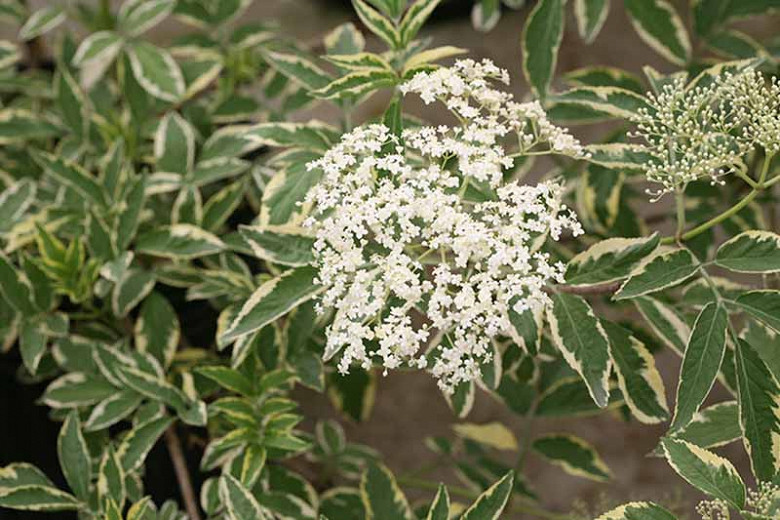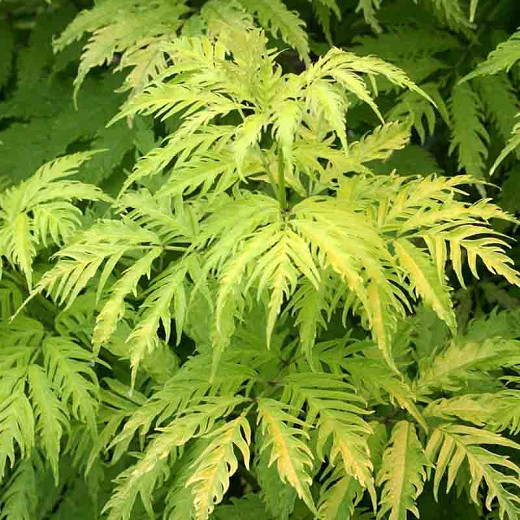Sambucus racemosa (Red Elderberry)
Perfect for traditional and wildlife gardens, Sambucus racemosa (Red Elderberry) is a deciduous suckering shrub or small tree adorned with opposite, pinnately compound, green leaves, 6-9 in. long (15-22 cm). Each individual leaf is composed of 5-7 leaflets, lance-shaped to narrowly oval, and deeply incised along the edges. In late spring to early summer, abundant conical clusters of tiny, fragrant, white flowers appear near the branch tips. Attractive to hummingbirds and butterflies, they give way to upright clusters of red berries that are happily devoured by birds in the fall. Native to Europe, northern temperate Asia, and North America across Canada and the United States, Red Elderberry occurs naturally in moist woodlands, thickets, stream banks, fields, fence rows and roadsides. Colorful from spring through fall, this easy-to-grow shrub looks wonderful in mixed borders or as a high-impact specimen plant. Adaptable in gardens, tolerant of wet soils and partial shade, neither of which will diminish fruit set. Will tolerate full sun in northern climates, but prefers part shade in warmer areas.
- Grows up to 8-12 ft. tall (240-360 cm) and 8-15 ft. wide (240-450 cm). This plant spreads by root suckers to form colonies.
- Performs best in full sun or part shade, in moderately fertile, humus-rich, moist, well-drained soils.
- Excellent choice as a single specimen plant, for mixed borders, informal screens or hedges. Mass in naturalized areas where suckering spread may be appreciated. The dense roots and rhizomes of red elderberry make it useful for soil stabilization and erosion control on moist sites including streambanks.
- May be subject to verticillium wilt, blackfly and glasshouse red spider mite. Deer resistant.
- Propagate by seed, softwood cuttings or hardwood cuttings. Seeds germinate readily after cold-stratification, as long as the fruit can be harvested before a mob of songbirds consumes the entire crop.
- Benefits from hard pruning as a young plant to develop a nice full habit. Older plants can be trimmed after flowering. This plant blooms on old wood, so spring pruning will reduce flower production.
- All parts may cause discomfort if ingested
- Native to Europe, northern temperate Asia, and North America across Canada and the United States.
Requirements
| Hardiness | 3 – 7 |
|---|---|
| Heat Zones | 1 – 7 |
| Climate Zones | 1, 1A, 1B, 2, 2A, 2B, 3, 3A, 3B, 4, 5, 6, 14, 15, 16, 17, A2, A3 |
| Plant Type | Shrubs, Trees |
| Plant Family | Sambucus – Elder |
| Exposure | Full Sun, Partial Sun |
| Season of Interest | Spring (Late)Summer (Early,Mid,Late)Fall |
| Height | 8' – 12' (240cm – 3.6m) |
| Spread | 8' – 15' (240cm – 4.5m) |
| Spacing | 108″ – 240″ (270cm – 600cm) |
| Water Needs | Average, High |
| Maintenance | Average |
| Soil Type | Chalk, Clay, Loam, Sand |
| Soil pH | Acid, Alkaline, Neutral |
| Soil Drainage | Moist but Well-Drained |
| Characteristics | Fragrant, Showy, Fruit & Berries |
| Native Plants | United States, Alaska, California, Illinois, Indiana, Iowa, Michigan, Minnesota, Missouri, North Dakota, Ohio, South Dakota, Wisconsin, Northeast, Connecticut, Maine, Massachusetts, Maryland, New Hampshire, New Jersey, New York, Pennsylvania, Rhode Island, Vermont, Pacific Northwest, Idaho, Oregon, Washington, Rocky Mountains, Colorado, Montana, Utah, Wyoming, Southeast, Georgia, Kentucky, North Carolina, Tennessee, Virginia, West Virginia, Southwest, Nevada, Arizona, New Mexico |
| Tolerance | Deer, Wet Soil |
| Attracts | Birds, Butterflies, Hummingbirds |
| Garden Uses | Beds and Borders, Hedges and Screens |
| Garden Styles | Coastal Garden, Informal and Cottage |
